David Stairs
I thought I knew trucks. After all, growing up in America, land of monster 56′ long behemoths, every boy wants to be a truck driver at some point. I vividly remember a trip along Interstate 80, the most intense truck route in the U.S., when there were so many trucks and seemingly only trucks all around me in my little 1971 BMW 2002 that I began to wonder if I was on the wrong road.
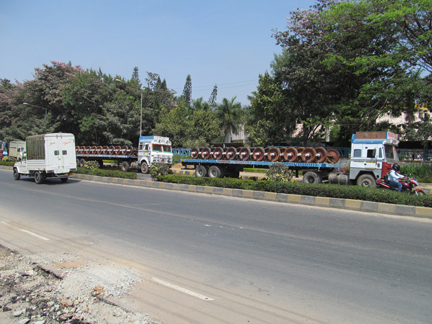
Flatbeds loaded with railway wheels
Fast forward to India, birthplace of Tata. When I lived in Africa, I saw Volvos and Macks, and various other brands of lorry inching their way along the trans-Africa highway that snakes from Mombassa to Kigali. Familiar to Africa, if largely because they were so dirty, were the Tatas. I knew Tata was a large Indian manufacturing conglomerate, but I really did not understand the scale of the company, which is into steel, medicine, banking, hotels, and computing, to name only a few branches of the company. Tata not only produces cars, like the recently famous Nano, but buses, trucks, and transmission systems.

My first weeks in Bengaluru I lived on the city’s outskirts. There was a lot of construction, virtually uncontrolled growth, and loaded lorries were driving, parking, and dumping everywhere.

 Designs on lorry doors
Designs on lorry doors
Indian trucks and buses are not only large and generally overloaded, but they have enormous air horns which their drivers frequently use and to startling impact. They are also decorated. I have seen fancy chrome wheels, exterior lights, and shrink-wrap super graphics on American 18-wheelers and rock-star caravans, but the Indian equivalent is much more charmingly down-to-earth.

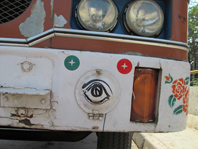 Guardian eyes
Guardian eyes
Often these designs are hand painted, brightly colored, and include clever patterns, designs, or reflector arrays. Floral patterns are not uncommon. Eyes can be painted on either the bumpers or the hood in an effort to keep hostile forces away. And even the mudflaps are considered. There is, of course, an American equivalent to this in the famous silhouette of a busty girl, which reinforces the reputation of truckers for being itinerant rogues. Indian lorry mudflaps are a bit more modest, usually comprising floral or mandala patterns stenciled on using spray paint.
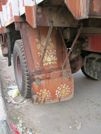
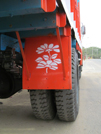
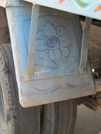
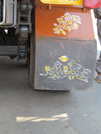
I have yet to witness any road accidents involving trucks or buses in India, a commonplace in the news in Africa. But, given the number of speed bumps on Bangalore roads, I have been alarmed to see most dump trucks loaded to, at minimum, a foot above the top of the box. With sand this does not seem a problem; it’s usually well wetted down. But the loads of stone could be more problematic.


India’s GDP is growing at a steady 6% clip, fueled by a building boom, in no small part supported by its fleet of giant lorries. Given the numbers on Indian roads, and their addition to India’s ubiquitously smoggy air, one can at least be assured that they are interesting to look at.
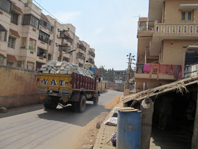
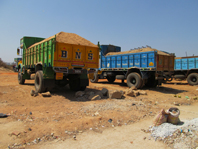

Wood truck on the road to Munnar
David Stairs is the founding editor of Design-Altruism-Project











Leave a Reply
You must be logged in to post a comment.